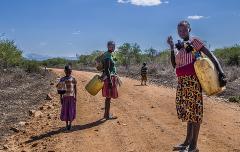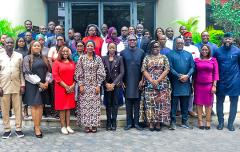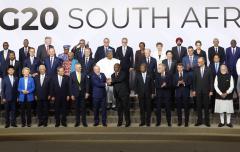Financing Sustainable Energy for All ‘is possible’
As the Financing for Development (FFD) process kicks off in New York, SEforALL presents solutions for financing sustainable energy for all.
 ‘It is important to de-risk investment opportunities and create enabling environments, including regulatory predictability and deploying de-risking tools. Public sector investments can also contribute by preparing the ground and therefore stimulate increased private investments,’ mentioned Mohinder Gulati, as some of the examples for areas to focus on.
‘Organizations like the World Bank can provide guarantees or insurance products. But many Development Finance Institutions (DFIs) do not yet have guarantee programmes. So to see such DFI programmes grow, modelled on the World Bank’s guarantee programme, would be a significant step forward,’ said Richard MacGeorge of the World Bank.
‘We find that for every dollar of guarantee we provide, we leverage six dollars of private sector investments. So the leveraging effect is very substantial,’ he added.
During the questions and answer segment with the audience, the panel was asked about the concept of Green Bonds, which is also highlighted in the report of the Committee on Mobilizing Finance and Investments.
‘One type of this is project-based Green Bonds. As an example, Bank of America recently arranged a bond for solar projects in Peru. One of the reasons that bond was able to attract investors from the U.S. capital markets, in that case, was because a Latin American development bank came in as an anchor investor into the project, which then gave other, private investors, comfort. This is a good example of public investments playing a role as de-risking the perception of the projects for private capital to come in,’ explained Abyd Kamali of the Bank of America.
The Committee on Mobilizing Finance and Investments is being co-led by Dr. Luciano Coutinho, President of the Brazilian National Development Bank (BNDES) and Mr. Purna Saggurti, Chairman of Global Corporate and Investment Banking, Bank of America Merrill Lynch (BAML).
A draft report was presented at the first annual United Nations Sustainable Energy for All Forum in New York in June 2014, including with concrete ideas and tools for how to mobilize USD 120 billion a year in added energy sector investments across four themes. The Committee’s draft report, prepared by BNDES, BAML and the World Bank, can be downloaded from here.
‘It is important to de-risk investment opportunities and create enabling environments, including regulatory predictability and deploying de-risking tools. Public sector investments can also contribute by preparing the ground and therefore stimulate increased private investments,’ mentioned Mohinder Gulati, as some of the examples for areas to focus on.
‘Organizations like the World Bank can provide guarantees or insurance products. But many Development Finance Institutions (DFIs) do not yet have guarantee programmes. So to see such DFI programmes grow, modelled on the World Bank’s guarantee programme, would be a significant step forward,’ said Richard MacGeorge of the World Bank.
‘We find that for every dollar of guarantee we provide, we leverage six dollars of private sector investments. So the leveraging effect is very substantial,’ he added.
During the questions and answer segment with the audience, the panel was asked about the concept of Green Bonds, which is also highlighted in the report of the Committee on Mobilizing Finance and Investments.
‘One type of this is project-based Green Bonds. As an example, Bank of America recently arranged a bond for solar projects in Peru. One of the reasons that bond was able to attract investors from the U.S. capital markets, in that case, was because a Latin American development bank came in as an anchor investor into the project, which then gave other, private investors, comfort. This is a good example of public investments playing a role as de-risking the perception of the projects for private capital to come in,’ explained Abyd Kamali of the Bank of America.
The Committee on Mobilizing Finance and Investments is being co-led by Dr. Luciano Coutinho, President of the Brazilian National Development Bank (BNDES) and Mr. Purna Saggurti, Chairman of Global Corporate and Investment Banking, Bank of America Merrill Lynch (BAML).
A draft report was presented at the first annual United Nations Sustainable Energy for All Forum in New York in June 2014, including with concrete ideas and tools for how to mobilize USD 120 billion a year in added energy sector investments across four themes. The Committee’s draft report, prepared by BNDES, BAML and the World Bank, can be downloaded from here.
 The second annual United Nations Sustainable Energy for All Forum has been announced to take place between 17 and 21 May 2015 at and around the United Nations headquarters in New York. Its main theme will again be the topic of Financing Sustainable Energy for All, including with the launch of a new Global Sustainable Energy for All Commitment Platform.
‘As such, the second SEforALL Forum in May will provide an opportunity to pick up on the important topic of financing sustainable energy for all,’ said Ms. Thompson, looking ahead at a year with decisions at the United Nations Summit for the adoption of the post-2015 development agenda in New York in September and the United Nations Climate Change Conference in Paris in December.
Photo credit: Svetlana Izrailova
The second annual United Nations Sustainable Energy for All Forum has been announced to take place between 17 and 21 May 2015 at and around the United Nations headquarters in New York. Its main theme will again be the topic of Financing Sustainable Energy for All, including with the launch of a new Global Sustainable Energy for All Commitment Platform.
‘As such, the second SEforALL Forum in May will provide an opportunity to pick up on the important topic of financing sustainable energy for all,’ said Ms. Thompson, looking ahead at a year with decisions at the United Nations Summit for the adoption of the post-2015 development agenda in New York in September and the United Nations Climate Change Conference in Paris in December.
Photo credit: Svetlana Izrailova
- Video: Watch the presentations in full
- Flyer: Two-pager made available at the event
- Presentation: PowerPoint slides from the event
- Report: SEforALL finance committee report
 ‘It is important to de-risk investment opportunities and create enabling environments, including regulatory predictability and deploying de-risking tools. Public sector investments can also contribute by preparing the ground and therefore stimulate increased private investments,’ mentioned Mohinder Gulati, as some of the examples for areas to focus on.
‘Organizations like the World Bank can provide guarantees or insurance products. But many Development Finance Institutions (DFIs) do not yet have guarantee programmes. So to see such DFI programmes grow, modelled on the World Bank’s guarantee programme, would be a significant step forward,’ said Richard MacGeorge of the World Bank.
‘We find that for every dollar of guarantee we provide, we leverage six dollars of private sector investments. So the leveraging effect is very substantial,’ he added.
During the questions and answer segment with the audience, the panel was asked about the concept of Green Bonds, which is also highlighted in the report of the Committee on Mobilizing Finance and Investments.
‘One type of this is project-based Green Bonds. As an example, Bank of America recently arranged a bond for solar projects in Peru. One of the reasons that bond was able to attract investors from the U.S. capital markets, in that case, was because a Latin American development bank came in as an anchor investor into the project, which then gave other, private investors, comfort. This is a good example of public investments playing a role as de-risking the perception of the projects for private capital to come in,’ explained Abyd Kamali of the Bank of America.
The Committee on Mobilizing Finance and Investments is being co-led by Dr. Luciano Coutinho, President of the Brazilian National Development Bank (BNDES) and Mr. Purna Saggurti, Chairman of Global Corporate and Investment Banking, Bank of America Merrill Lynch (BAML).
A draft report was presented at the first annual United Nations Sustainable Energy for All Forum in New York in June 2014, including with concrete ideas and tools for how to mobilize USD 120 billion a year in added energy sector investments across four themes. The Committee’s draft report, prepared by BNDES, BAML and the World Bank, can be downloaded from here.
‘It is important to de-risk investment opportunities and create enabling environments, including regulatory predictability and deploying de-risking tools. Public sector investments can also contribute by preparing the ground and therefore stimulate increased private investments,’ mentioned Mohinder Gulati, as some of the examples for areas to focus on.
‘Organizations like the World Bank can provide guarantees or insurance products. But many Development Finance Institutions (DFIs) do not yet have guarantee programmes. So to see such DFI programmes grow, modelled on the World Bank’s guarantee programme, would be a significant step forward,’ said Richard MacGeorge of the World Bank.
‘We find that for every dollar of guarantee we provide, we leverage six dollars of private sector investments. So the leveraging effect is very substantial,’ he added.
During the questions and answer segment with the audience, the panel was asked about the concept of Green Bonds, which is also highlighted in the report of the Committee on Mobilizing Finance and Investments.
‘One type of this is project-based Green Bonds. As an example, Bank of America recently arranged a bond for solar projects in Peru. One of the reasons that bond was able to attract investors from the U.S. capital markets, in that case, was because a Latin American development bank came in as an anchor investor into the project, which then gave other, private investors, comfort. This is a good example of public investments playing a role as de-risking the perception of the projects for private capital to come in,’ explained Abyd Kamali of the Bank of America.
The Committee on Mobilizing Finance and Investments is being co-led by Dr. Luciano Coutinho, President of the Brazilian National Development Bank (BNDES) and Mr. Purna Saggurti, Chairman of Global Corporate and Investment Banking, Bank of America Merrill Lynch (BAML).
A draft report was presented at the first annual United Nations Sustainable Energy for All Forum in New York in June 2014, including with concrete ideas and tools for how to mobilize USD 120 billion a year in added energy sector investments across four themes. The Committee’s draft report, prepared by BNDES, BAML and the World Bank, can be downloaded from here.
 The second annual United Nations Sustainable Energy for All Forum has been announced to take place between 17 and 21 May 2015 at and around the United Nations headquarters in New York. Its main theme will again be the topic of Financing Sustainable Energy for All, including with the launch of a new Global Sustainable Energy for All Commitment Platform.
‘As such, the second SEforALL Forum in May will provide an opportunity to pick up on the important topic of financing sustainable energy for all,’ said Ms. Thompson, looking ahead at a year with decisions at the United Nations Summit for the adoption of the post-2015 development agenda in New York in September and the United Nations Climate Change Conference in Paris in December.
Photo credit: Svetlana Izrailova
The second annual United Nations Sustainable Energy for All Forum has been announced to take place between 17 and 21 May 2015 at and around the United Nations headquarters in New York. Its main theme will again be the topic of Financing Sustainable Energy for All, including with the launch of a new Global Sustainable Energy for All Commitment Platform.
‘As such, the second SEforALL Forum in May will provide an opportunity to pick up on the important topic of financing sustainable energy for all,’ said Ms. Thompson, looking ahead at a year with decisions at the United Nations Summit for the adoption of the post-2015 development agenda in New York in September and the United Nations Climate Change Conference in Paris in December.
Photo credit: Svetlana Izrailova



